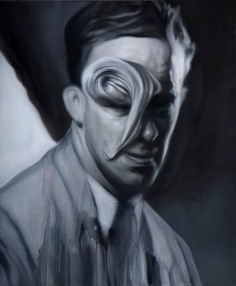Stephan Balleux

source:stephanballeuxcom
Balleux’s already quite considerable oeuvre, we find a paradigm expressing the mimetic stability of a figure and strategies for altering — ‘disfiguring’ — it. As if what has been the historical basis of painting since the Renaissance has been contradicted, not by the deconstruction of perspective — the work of the twentieth-century avant-garde — but by the inversion of the process towards resemblance, upon which the vanity of painting rested until then.
Stephan Balleux is the child of a century in which gathering images constituted the initial act of creation. As such, although a painter, he has inherited that doubt with regard to painting sown by Marcel Duchamp and deepened by the serial approaches of pop art and conceptual art.
His way of painting starts with a collection of already existing images, whereby he does not ‘paint’ so much as assemble. His real and entire aim as a painter is to disfigure.
Yet this is not mere destruction, commonplace devastation brought about by any bad painting. Indeed there is a sort of paradox in the means Stephan Balleux uses to disfigure an image, with the artist employing his mastery of figuration to disfigure. The symbol of this paradox resides in his strange magma of paint, his ‘blobs,’ as Balleux calls them. Seemingly daubed wildly on the canvas, yet in fact meticulously detailed down to the smallest folds and waves, they are, in my view, emblematic of his whole painterly oeuvre.
.
.
.
.
.
.
.
source:lagalerieparticulierecom
Stephan Balleux is a pluridisciplinary artist ; he is indeed an extraordinary painter but also a sculptor, as well as a videos or performances author. He is the child of a century during which collecting images was the inaugural act of creation. Thus, though he is a painter, he began doubting about painting, following the example of Marcel Duchamp and later of serial approaches of Pop art and conceptual art. He is painting from the collection of images already existing and differs painting itself by collecting. Then his ambition as a painter is entirely dedicated to de-featuring. But such an ambition does not only consist in destruction or in a common devastation due to some bad painting ; there is indeed some kind of paradox in the means used by Stephan Balleux to de-feature. He de-features by being a master of featuring. The symbol of this paradox relies in this strange paint magma, savagely brushed aside as well as meticulously detailed in every single fold or wave and which the artist calls « blob » and which symbolizes his whole production of painted images.
In many artworks, this artificial form seems to benefit from the same weightlessness as the one of a cloud : a hanging and pending form which questions banal images in order to reveal a new signification. On the other side, when it is invasive, attacking on monuments or human activities, it invades the faces and seems to recover it all. This is the case for this series of portraits that we are showing, i.e. women’s faces, whether seductive women or mothers – some of them coming from our collective imagination and which seem to be battling with their rough futures, i.e. a kind of future perfect.
This is precisely this confusion, this impossibility to decide on human beings and their identities, which extends to the material itself and which might well be at the root of Stephan Balleux’s work. The confusion centers around and mainly expresses itself through the idea of fuzziness as a process but also in terms of reception : « No image can escape from fuzziness, neither can any sound escape from scattering. Reality itself is web of vagueness. Fuzziness never stops questioning both our perception and our representation of the world and reactivating them as if it was concealing or telling a promise of clearness, knowledge, beauty, something beyond confusion – Fuzziness is a prerequisite in our relationship to the world and to artworks ». It is about identity confusion, confusion of the material through deterritorialisations and its disguises but also about the artist questioning himself. Indeed, beyond the diversified and disturbing nature of the suggested artworks, Stephan Balleux’s work quickly strikes by the coherence as well as by the pertinence of his questioning. He really asks himself about identity and painting’s place in a digital and virtual age.

